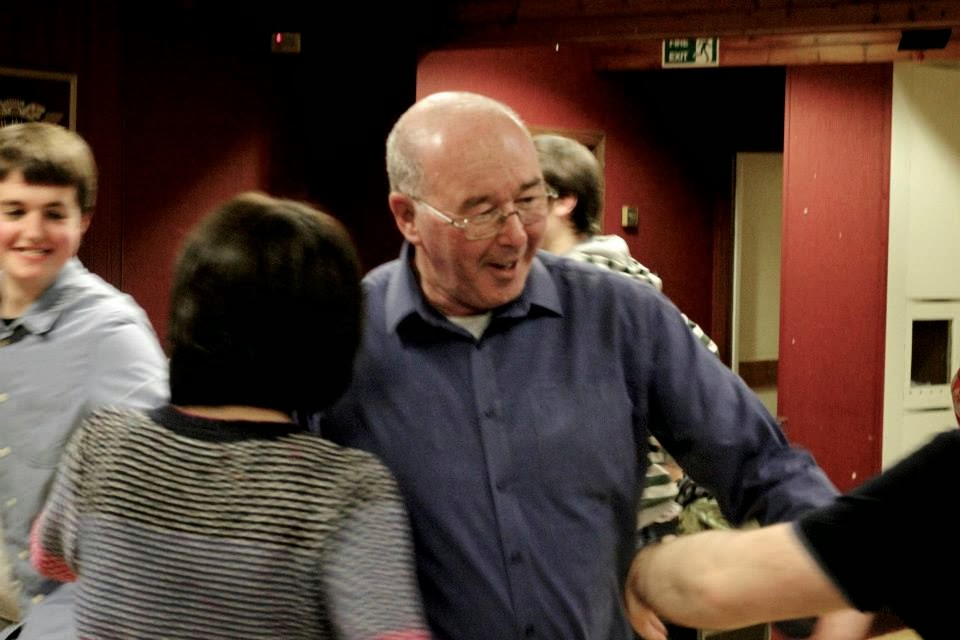The Cheviot, The Stag, The Oil & The Green Green Golf Course
Working on a Scottish classic
 |
| Image by David McGarvey
My most recent project is a very interesting one, I am co-directing (alongside Prof Maggie Kinloch) the John McGrath classic 'The Cheviot, The Stag and the Black Black Oil' for the Largs Players community drama group, also featuring the mod-winning Largs Gaelic choir (you can see photos from our production here). The play was first performed by 7:84 (pictured below) who toured it all around Scotland and, in doing so, created a classic piece of Scottish theatre.

It is an interesting experience to work on this play for a number of reasons. The most obvious being the text itself, it's unlike any play that I've ever come across and I doubt will come across again. Here's a little snippet of the opening number.
The PlayThe play was first performed 40 years ago, in 1974. It tells the story of the Scottish Highlands from 1746 up until - the then - modern day. It looks at how the people and their land were originally exploited for the Cheviot, a type of sheep that could endure the harsh winter, then for the Stag hunts that the gentry would pay top-dollar for and, finally, for the Black Black Oil of the North sea. Interestingly this idea of exploitation from outside sources has continued right up to this present day, one watch of the documentary 'You've Been Trumped' will testify that the Scottish working class is still very much pitted against powerful men, and organisations, with money. That is one reason why I think the play still stands on it's feet to this day, it is a historical piece in a number of ways (caricatures of 'Red Indians' in America's heartland being just one example of how we have moved on since the 70's) but the core message is very much relevant. |
 |
| John Byrne with his original set |
 |
| Our production started off with a giant White Paper |
However, though it does not have nationalism at it's core, we hope that it will help influence the debate. We have written a short introduction to the play, to be performed on the night, that contextualises it for the modern audience and we also ask for it to inform their thinking when deciding on whether they will vote 'yes' or 'no'. It is not a straight-forward argument and the play does not try and preach one way or the other, but it does a great job of contextualising how we have got to where we have got to.
With a play that has socialism right at it's heart is should not come as a surprise to find that it's sights are firmly locked onto the land-owning gentry. It shows how they were quick to sell to the highest bidder without a moments thought for those who lived on the land. The stories that are told in the play are hard-hitting, some are shockingly brutal yet there is also a levity that makes it an enjoyable night out. It is this counterbalance between the hard politics and the ever-persevering Scottish humour that make it really work as a play. One moment the audience are all singing along to "These are my Mountains" the next they are being told of the horrific injuries that woman protecting their village suffered at the hands of the police. Below is a short video with the cast having their first sing-along of "These are my Mountains".
The Language and the Music
The play is set out in the structure of a ceilidh. It moves effortlessly through time and situations with the scenes being punctuated by music from a ceilidh band and, in our production, a Gaelic choir (in the original, so I believe, there was one Gaelic singer). We are very lucky to have the Largs Gaelic choir onboard for this production. The presence of the Gaelic language, and it's destruction as the play progresses, is one of the most powerful motifs of the play. The choir are continually told to stop singing in 'that language that nobody can understand' but defiantly they keep on reappearing until the final angry, rousing song by Mary MacPherson reverberates around the theatre. This is, again, an issue that is very current. Their has been a rebirth of the language in recent years and it is interesting to see how the negativity felt towards it surviving in the 70's now - perhaps - seems a little premature. The actors have also been learning Gaelic as there are sections of the play that are written in the language, and everybody joins in the final song. Below is a little video of the choir in action a couple of years ago.
Our musical director, Ryan Moir, is also working away at creating an underscore for the band that will help glue the show together and provide momentum to the piece. There are numerous songs that play on famous tunes that everybody will know and you'll find just as many hummable tunes in this show than you would in any West End hit!
The Community
 |
| Maggie works with the cast |
 |
| The cast are truly representative of the local community |
Rehearsals have been fun and challenging in equal measure! Having two directors has allowed us to work in separate locations on different parts of the story, there are no characters that continue throughout the piece, it does not follow a narrative like most plays. Instead the constant is the land, the people of Scotland and their exploiters. So we hear stories from sheep farmers, from Aberdonian riggers, from Texan billionaires, from dodgy businessmen and - in what I think is the funniest and most touching scene - from a crofter and his wife who are forced to open their doors to tourists as they contemplate moving from their Aberdonian croft to a flat... somewhere.
It is hugely challenging for the actors to pull off so many characters in such a short space of time and keep the whole thing held together, but I am confident that we are in a really good place to create an exciting, thought provoking show.
 |
| Maggie putting the cast through their paces |
 |
| This is my good self trying to work out what's going on! |



Comments
Post a Comment